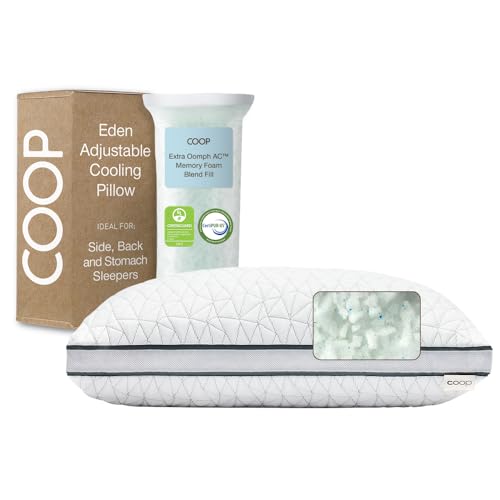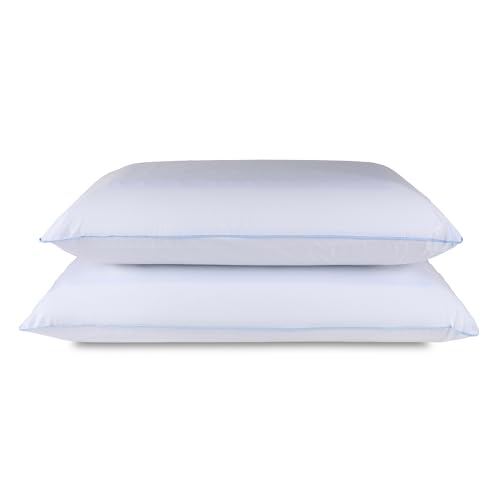Disclosure
This website is a participant in the Amazon Services LLC Associates Program, an affiliate advertising program designed to provide a means for us to earn fees by linking to Amazon.com and affiliated sites.
Side sleeping offers a range of science-backed health benefits that go far beyond just comfort. From improved digestion to reduced risk of neurological decline, this sleep position has been consistently recommended by health experts and sleep scientists alike.
Have you ever wondered why you naturally curl up on your side when you’re tired? You’re not alone—and there’s actually a biological reason for it. Studies show that side sleeping can enhance waste clearance in the brain, support heart health, and ease symptoms of sleep apnea and acid reflux. It’s not just about preference—it’s about positioning your body to rest in alignment with its natural functions.
Best Pillows for Side Sleeping
Choosing the right pillow can make or break your side sleeping experience. The right support helps maintain spinal alignment, reduce pressure points, and improve sleep quality. Here are three of the best pillows for side sleepers that stand out for comfort, design, and customer satisfaction:
1. Coop Home Goods Eden Adjustable Pillow
- Enhanced Breathability for Better Sleep: Designed with a blend of soft,…
- Fully Adjustable, You Are in Control: Experiencing discomfort, snoring or…
- Is Your Pillow Green Guard Gold Certified?: Our Coop Home Goods Eden Pillows…
- Why we picked it: This pillow offers customizable fill, cooling gel-infused memory foam, and excellent neck support—perfect for maintaining healthy alignment throughout the night.
2. Tempur-Pedic TEMPUR-Cloud Breeze Dual Cooling Pillow
- Helps relieve aches and pains: TEMPUR-Material precisely adapts to your head,…
- TEMPUR-Material: A single piece of our one-of-a-kind, infinitely adaptable…
- Cooling Gel Layers: A layer of Tempur-Pedic Cooling Technology is added to both…
- Why we picked it: Designed with TEMPUR material and cooling gel layers, this pillow adapts to your body shape while keeping you cool, making it ideal for side sleepers who run warm.
3. Eli & Elm Side Sleeper Pillow
- Ergonomic Design: Unlike traditional pillows that push on your head at awkward…
- Adjustable Loft: There is no one size fits all pillow, which is why we included…
- Cooling and Breathable: The side sleeper pillow uses open cell latex noodle with…
- Why we picked it: Ergonomically designed with a unique U-shape, this pillow reduces shoulder pressure and supports the head and neck perfectly for side sleeping posture.
Improved Digestion and Reduced Acid Reflux
One of the most immediate and noticeable benefits of side sleeping—especially on the left side—is improved digestion and reduced symptoms of acid reflux. This is not just anecdotal; it’s rooted in anatomy and supported by clinical research.
When you lie on your left side, your stomach and gastric juices remain lower than your esophagus due to gravity. This significantly reduces the likelihood of stomach acid backing up into the esophagus, which can cause heartburn and damage over time. That’s why left-side sleeping is often recommended for people with GERD (Gastroesophageal Reflux Disease).
Why It Matters:
- Acid reflux affects millions of people daily and is often worse at night.
- Lying on the right side can relax the lower esophageal sphincter, increasing reflux risk.
- A 2010 study published in The Journal of Clinical Gastroenterology found that left-side sleeping reduced acid exposure by up to 71% compared to the right side.
Additional Digestive Perks:
- Enhances waste movement through the colon, aiding digestion.
- May ease symptoms of IBS and bloating in sensitive individuals.
- Helps the pancreas and bile function more efficiently by relieving abdominal compression.
Better Spinal Alignment and Joint Relief
Proper spinal alignment during sleep is crucial for overall health, and side sleeping—when done correctly—can significantly support the natural curvature of your spine. This position helps reduce strain on the back and neck and minimizes pressure on the hips and shoulders, two areas commonly stressed during sleep.
When your spine is aligned, your muscles can fully relax, leading to better recovery, improved posture during the day, and less pain upon waking. But the key lies in maintaining proper alignment with the help of a supportive pillow and mattress.
Key Benefits for Spinal Health:
- Keeps the head, neck, and spine in a neutral position.
- Helps relieve lower back pain by reducing pressure on the lumbar area.
- Promotes muscle relaxation and minimizes morning stiffness.
Joint-Friendly Advantages:
- Side sleeping takes pressure off the spine and places it on the side of the body, which is cushioned by muscle and fat.
- Sleeping with a pillow between your knees can further support hip alignment and reduce joint strain.
- Beneficial for those with arthritis or chronic joint pain, as it reduces direct bone-on-bone contact and inflammation triggers.
Pro Tip:
Use a firm pillow to support your head and neck, and consider a medium-firm mattress that supports the body’s natural curves while cushioning the pressure points.
Supports Brain Health and Nighttime Detoxification
Side sleeping doesn’t just help your muscles and digestion—it also plays a surprisingly powerful role in maintaining brain health. Recent neurological research suggests that this position can enhance the brain’s natural detox process, especially during deep sleep.
The Science Behind It:
When you sleep, your brain enters a cleansing mode through the glymphatic system, a network that removes waste and toxins—including beta-amyloid and tau proteins, which are linked to Alzheimer’s and other neurodegenerative diseases.
Researchers at Stony Brook University found that sleeping on your side, compared to your back or stomach, allows cerebrospinal fluid to flow more efficiently—clearing toxins faster and more thoroughly.
Benefits for Brain Function and Long-Term Health:
- Enhanced toxin removal: Side sleeping improves clearance of metabolic waste by up to 25%.
- Better sleep cycles: This position supports deeper, more restful sleep—key for memory consolidation.
- May lower risk of neurological diseases: By reducing buildup of harmful proteins, side sleeping may decrease the risk of Alzheimer’s and Parkinson’s.
Quick Tips for Maximizing Brain Detox During Sleep:
- Sleep on your left side for the added benefit of improved lymphatic drainage.
- Avoid sleeping on your stomach—it can reduce glymphatic efficiency and strain your neck.
- Use a contoured pillow that aligns your neck and spine without compressing the head.
Reduces Snoring and Sleep Apnea Symptoms
Snoring and obstructive sleep apnea (OSA) affect millions of people and can severely impact sleep quality—not just for the sleeper, but for their partner too. Fortunately, side sleeping is one of the most effective, non-invasive ways to manage these issues.
When you sleep on your back, gravity causes the tongue and soft tissues to collapse backward, narrowing or blocking the airway. Side sleeping helps keep the airway open, making breathing more efficient and reducing the risk of snoring and apnea episodes.
How Side Sleeping Helps:
- Keeps airways open: Reduces the collapse of the tongue and soft palate.
- Minimizes apnea episodes: Many people with mild to moderate OSA experience fewer breathing interruptions when side sleeping.
- Decreases snoring: By improving airflow, side sleeping makes snoring less frequent and less intense.
Evidence You Can Trust:
- According to the American Academy of Sleep Medicine, positional therapy (changing sleep position) can significantly reduce apnea severity for those with positional sleep apnea.
- A 2012 study found that people with sleep-disordered breathing experienced up to 50% fewer events when sleeping on their side versus their back.
Practical Tips for Side Sleepers with Breathing Issues:
- Use a body pillow to help stay in position and avoid rolling onto your back.
- Elevate your head slightly with a firm pillow to further promote open airways.
- Avoid heavy meals or alcohol before bed—these can worsen snoring regardless of position.
Promotes Healthy Circulation and Safer Sleep During Pregnancy
Side sleeping, especially on the left side, is the gold standard for pregnant individuals. As the baby grows, sleep becomes more challenging, and the body requires optimal circulation to support both maternal and fetal health. Left-side sleeping helps facilitate this better than any other position.
The reason? It reduces pressure on the inferior vena cava (IVC)—the large vein that returns blood from the lower body to the heart. Sleeping on your back in later pregnancy can compress this vein, potentially limiting blood flow and oxygen delivery to the baby.
Key Benefits for Pregnant Women:
- Boosts blood flow to the uterus, kidneys, and fetus.
- Supports better breathing by keeping pressure off the diaphragm.
- Reduces swelling in the legs, ankles, and feet by improving circulation.
- Alleviates back pain and pressure on the spine and hips.
Important Pregnancy Sleep Guidelines:
- Left-side sleeping is ideal, especially in the second and third trimesters.
- Avoid sleeping on your back for prolonged periods during late pregnancy.
- Use a pregnancy pillow or wedge to maintain position and relieve joint pressure.
Research Insight:
- A study published in The BMJ suggested that sleeping on the left side during pregnancy is associated with a lower risk of stillbirth compared to other positions.
- Doctors and midwives frequently recommend this posture to support fetal development and maternal comfort.
Conclusion
Side sleeping isn’t just a cozy habit—it’s a powerful tool for improving health, comfort, and long-term well-being. Whether you’re managing chronic pain, dealing with digestive issues, or simply want to wake up feeling refreshed, adjusting your sleep position could be the key.
Here’s a quick recap of the benefits of side sleeping:
- Improves digestion and reduces acid reflux, especially on the left side.
- Supports spinal alignment and relieves joint pressure.
- Enhances brain detoxification, potentially reducing the risk of neurological disease.
- Reduces snoring and helps manage sleep apnea.
- Promotes circulation during pregnancy, supporting both mom and baby.
But remember—position alone isn’t enough. Pair your side sleeping habit with:
- A supportive pillow that keeps your head and neck aligned.
- A comfortable mattress that cushions pressure points.
- Good sleep hygiene, like a calm environment and regular routine.
Frequently Asked Questions About Side Sleeping
Is sleeping on your side better than on your back?
- Yes, for most people. Side sleeping supports better digestion, reduces snoring, and promotes spinal alignment.
- Back sleeping can worsen snoring, sleep apnea, and acid reflux in some individuals.
- People with sleep apnea or GERD often find side sleeping significantly improves symptoms.
Which side is better: left or right?
- Left side sleeping is generally best:
- Supports heart health.
- Reduces acid reflux and helps with digestion.
- Recommended during pregnancy to improve blood flow.
- Right side is still better than back or stomach but may slightly increase reflux in some people.
Can side sleeping cause shoulder or hip pain?
- It can if your mattress or pillow lacks support:
- Use a medium-firm mattress to cushion pressure points.
- Place a pillow between your knees to keep hips aligned.
- Switch sides periodically to avoid overloading one side of the body.
Is side sleeping good for people with sleep apnea?
- Yes. Side sleeping helps keep airways open and reduces the number of apneas during the night.
- Consider positional therapy as part of your sleep apnea treatment plan.
- Avoid back sleeping, which worsens apnea in most cases.
How do I train myself to sleep on my side?
- Use a body pillow or wedge to prevent rolling onto your back.
- Start each night on your side and reinforce the habit with positioning aids.
- Sleep in a slightly fetal position for added comfort and spinal support.



